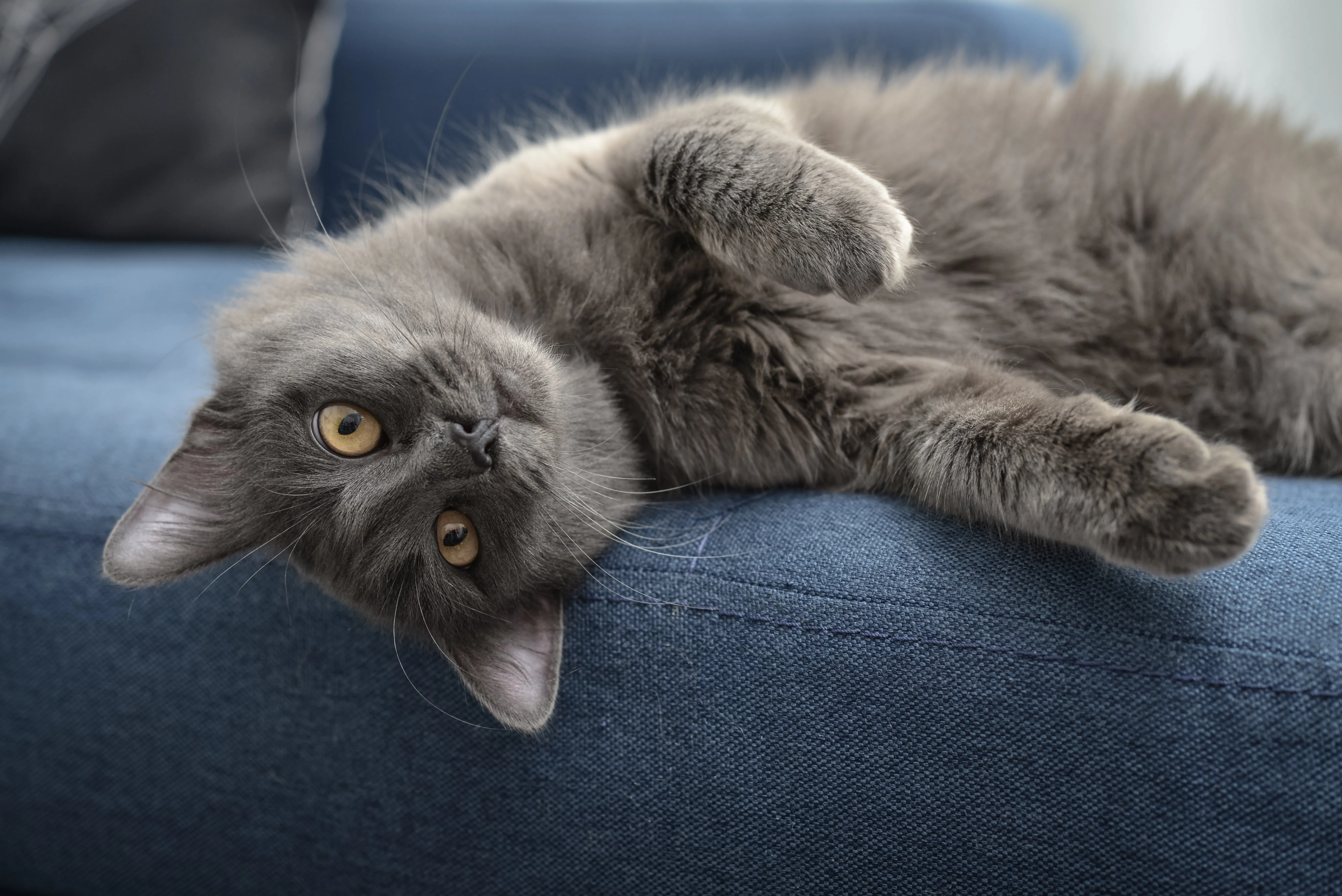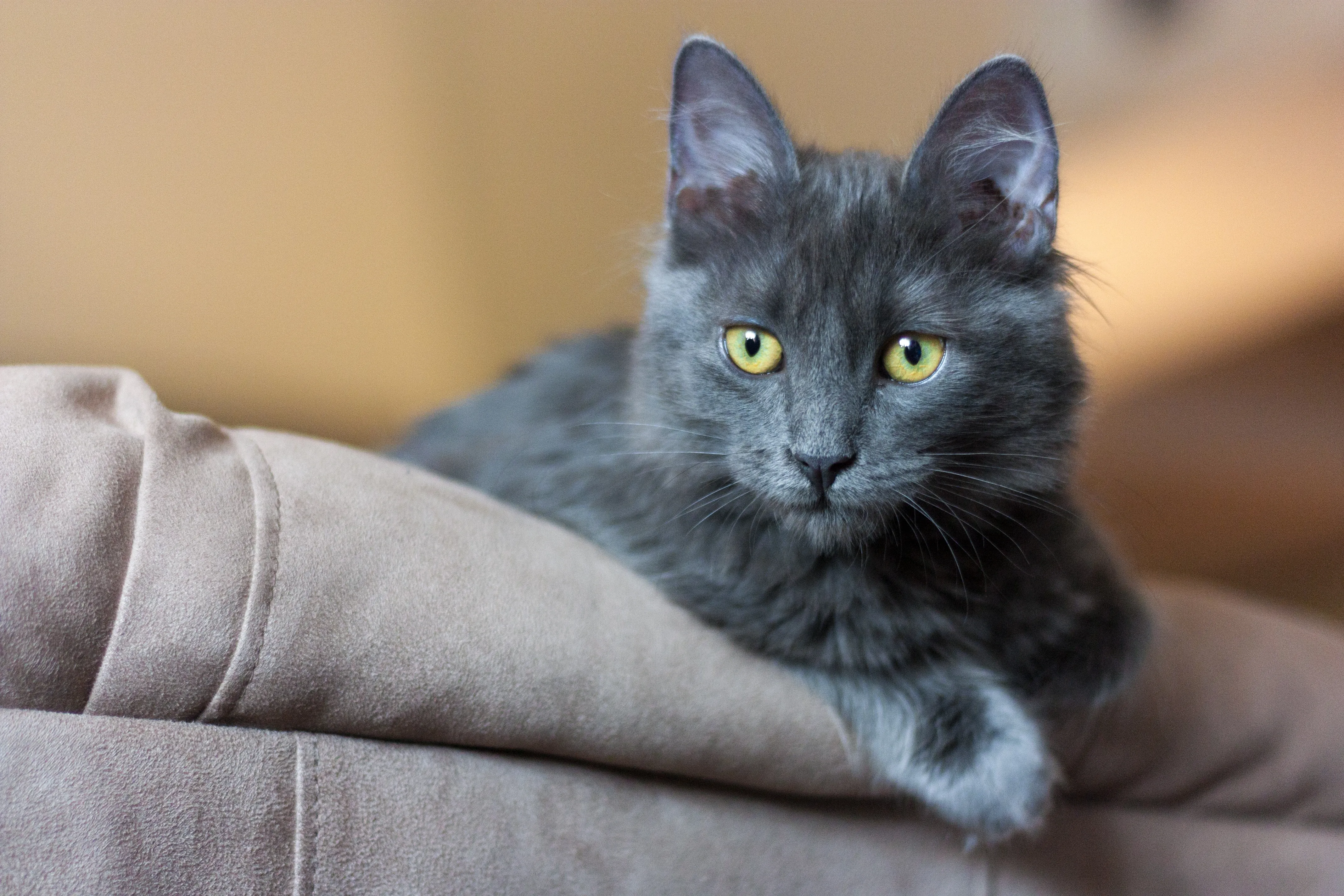Maine Coon
The Maine Coon has become one of the most popular cat breeds in the world. This is probably due to its majestic appearance, robust nature and great character.
With its silver-blue fur and shimmering green eyes, the Nebelung is a unique sight to behold and appreciated by many cat lovers. However, breeding is still in its infancy.

© Therese Elaine / adobe.stock.com
The graceful Nebelung captivates with its elegant, muscular physique. It weighs between 4 and 6kg, whilst males tend to be heavier. This makes it a medium-sized cat. Its elongated legs are of medium strength and the paws are oval-shaped. The large, slightly pointy ears sit on the wedge-shaped head.
The fur on the Nebelung’s tail is longer than on the rest of the body. One of its most striking characteristics is its semi-long ‘blue’ fur. In purely genetic terms, this is diluted black. The silver hair tips, known as ticking, give the impression that there is a silvery shimmer on the cat’s fur.
The eye colour varies from yellowish green to pure green. According to the standard, the Nebelung may not have any fur markings like patches or stripes. However, a final assessment of the fur can only take place at two years of age.
This cat breed originated from the US in the 1980s and was based on an accidental mating of two neighbourhood cats: A black Shorthair called Elsa with a long-haired father mated with a neighbourhood tomcat that resembled a Russian Blue. Both in 1984 and a year later, there was one kitten with a blue, semi-long coat amongst those born. The owner Cora Cobb named them Siegfried and Brunhilde after two heroic figures from the German Nibelung saga.
Cora Cobb discovered the unique nature of the Nebelung and was now determined to start a new breed with her cats. She contacted TICA (The International Cat Association). The geneticist Dr. Solveig Pflueger help her to establish the breed standard. Cora Cobb used the Russian Blue breed standard for orientation. She merely swapped the passage about permitted hair length: The Russian Blue has short fur and the Nebelung semi-long fur.
Originally, the breed was called Nibelung in reference to the heroic epic surrounding Siegfried and Brunhilde. The breeder later decided to tone down the reference to this historical matter. They changed the name to Nebelung, which is derived from the German word ‘Nebel’ (mist) and the silvery shimmer of the coat. TICA recognised this newly created cat breedin 1987. In contrast, the FiFe (Fédération Internationale Feline) has not to this day recognised the Nebelung as an independent breed.
 © tashka2000 / stock.adobe.com
© tashka2000 / stock.adobe.com
A Nebelung may look secretive and mystic. However, these elegant felines are down to earth: They enjoy stroking sessions and playing with their owners. They don’t need too much action on the agenda – Nebelung cats appreciate tranquility and familiar routines. Like all cats, they are very playful and easy-going during the kitten phase. These gentle cats are initially reserved towards strangers, but if you show some patience, you will get to know their charming ways.
The Nebelung makes a suitable domestic cat. Variety is of great importance for them. Hence, allow your cat a secured garden or balcony space and ideally keep it together with a second Nebelung. Spending time with their human family on a daily basis is also important for these sensitive cats. They generally form a close bond to one person, making them ideal for single-person households. If children also live in the household, they should be taught the correct way to handle four-legged friends. There should definitely be a cosy spot where the Nebelung can retreat to.
As yet, there is still little known about possible health problems or diseases typical of the Nebelung. Some owners report that this breed is prone to diarrhoea or vomiting. Both unfamiliar food and stress can have a negative impact on your Nebelung’s stomach. Hence, a balanced, feline-appropriate diet is particularly important with this breed. The Nebelung is considered robust: A cat in good health can reach 15 to 20 years of age.
As with all semi-longhair cats, Nebelung owners should brush or comb their cat at least once a week to prevent the fur from matting. Daily brushing may be necessary when they moult in spring and autumn. This doesn’t just rid them of dead hair, but also prevents hair getting spread all over your home. If matting has already occurred, you can use a dematting tool or comb for smaller areas.
Seeing a vet is recommended if matting has developed. If required, the vet can shear the cat under gentle sedation. It is best to get the Nebelung used to regular brushing sessions in a playful manner when it is still a kitten so that it enjoys being combed as an adult. If you don’t hurt your cat, brushing strengthens your bond and is like a pleasant feline massage. Older cats in particular may additionally require regular claw trimming.
 © Agnes Miragliotta / stock.adobe.com
© Agnes Miragliotta / stock.adobe.com
It is particularly important to offer a high-quality food to cats like the Nebelung that tend to be nutritionally sensitive. Make sure to choose a food with a high proportion of meat. Proceed slowly if you would like to change the food: Mix increasing portions of the new food into the usual one. By doing you so, you reduce the risk of your Nebelung suffering from hypersensitivity reactions like diarrhoea or vomiting. Monitor the weight of your adult Nebelung every few months.
The semi-long fur makes it harder to recognise if your cat has lost weight or is carrying too many kilos. However, weight gain can increase the risk of diseases like diabetes or joint problems in cats too. Radical diets aren’t an option. If you want your cat to lose weight, opt for balanced portions of high-quality food and reduce treats. To encourage cats to drink, you’re better off placing several bowls in different areas of your home. Make sure that the water and food bowl are not too close to each other.
If you’re looking for a Nebelung in Europe, you may have to accept long waits and travel times. This is because the Nebelung is still very rare over 30 years after it came into existence. Along with the US, there are also breeders in Canada and Russia, as well as some European countries.
If you’re looking for a Nebelung, you should solely contact reputable breeders. A responsible breeder is generally a member of a breeding association and looks after the wellbeing of mother and kitten. This involves regularly getting their cats examined by a vet and prioritising species-appropriate housing, as well as suitable socialisation for young animals. Accordingly, kittens should only be handed over with pedigree and vaccination certification. You should steer clear of breeders focused on quantity over quality who offer pedigree cats without the required paperwork.
It’s always worth visiting a local animal shelter too. Although it’s not very likely that you will find a Nebelung in an animal shelter, there are plenty of cats there waiting for a loving home. Maybe a charming hybrid will win you over.
| Origin | Developed in the United States from Russian Blue ancestors |
| Size | Medium |
| Weight | 4 – 7 kg (10 – 15 lbs) |
| Lifespan | 15 – 20 years |
| Uk Price | £1,000-1,200 |
| Temperament | Playful, Calm, Affectionate, Tends to bond with one person |
| Coat | Semi-longhaired, with silver-tipped guard hairs |
| Color | Blue coat with silver tipping |
Here are some purchase proposals curated by the zooplus editorial team
The products featured have been carefully selected by our editorial staff and are available at the zooplus online pet shop. The selection does not constitute advertising for the mentioned brands.
The Maine Coon has become one of the most popular cat breeds in the world. This is probably due to its majestic appearance, robust nature and great character.
Large eyes and attentively upright ears instantly tell you a great deal about this charming breed of cat: Abyssinians are inquisitive and affectionate towards people.
With its long, dense fur, rounded ears, and intense stare, the Pallas Cat, or Manul, looks rather fluffy, yet somewhat dangerous. However, don't be fooled by its appearance—this is no petting zoo resident. The Manul is a wild animal and considered untameable.